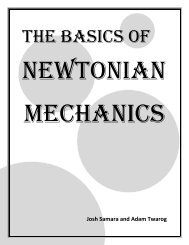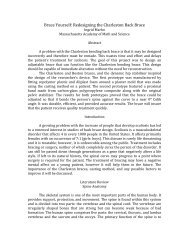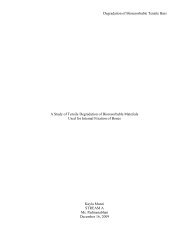tessella - the Scientia Review
tessella - the Scientia Review
tessella - the Scientia Review
You also want an ePaper? Increase the reach of your titles
YUMPU automatically turns print PDFs into web optimized ePapers that Google loves.
Case Study:<br />
M. C. Escher was a Dutch graphic artist that was famous for <strong>the</strong> <strong>tessella</strong>tions in<br />
his art. Born in 1898, his family lived in Leeuwarden, <strong>the</strong> Ne<strong>the</strong>rlands before<br />
moving to Arnhem. After high school he attended <strong>the</strong> Haarlem School of architecture<br />
and design. After failing to become an architect, Escher decided to<br />
study decorative arts. In 1937, he started to incorporate ma<strong>the</strong>matics into his<br />
Regular Division of <strong>the</strong> Plane III, woodcut, 1957 - 1958.<br />
artwork which consisted mostly of<br />
lithographs and woodcuts. From a paper<br />
by George Polya, Escher learned<br />
about <strong>the</strong> different symmetries used to<br />
create <strong>tessella</strong>tions. His 1936 Regular<br />
Division of <strong>the</strong> Plane work and his<br />
1937 work Metamorphosis I were some<br />
of his first works to make use of <strong>tessella</strong>tions.<br />
In 1958, he published a book<br />
called Regular Division of <strong>the</strong> Plane<br />
that was composed of his previous<br />
works that made use of <strong>tessella</strong>tions.<br />
His final work to use <strong>tessella</strong>tions was<br />
his Metamorphosis III which he made<br />
The concept of this work (Metamorphosis I) is to morph one image into a <strong>tessella</strong>ted pattern, <strong>the</strong>n gradually to alter <strong>the</strong><br />
outlines of that pattern to become an altoge<strong>the</strong>r different image. From left to right, <strong>the</strong> image begins with a depiction of<br />
<strong>the</strong> coastal Italian town of Atrani. The outlines of <strong>the</strong> architecture <strong>the</strong>n morph to a pattern of three dimensional blocks.<br />
These blocks <strong>the</strong>n slowly become a <strong>tessella</strong>ted pattern of cartoon like figures in oriental attire.<br />
16

















